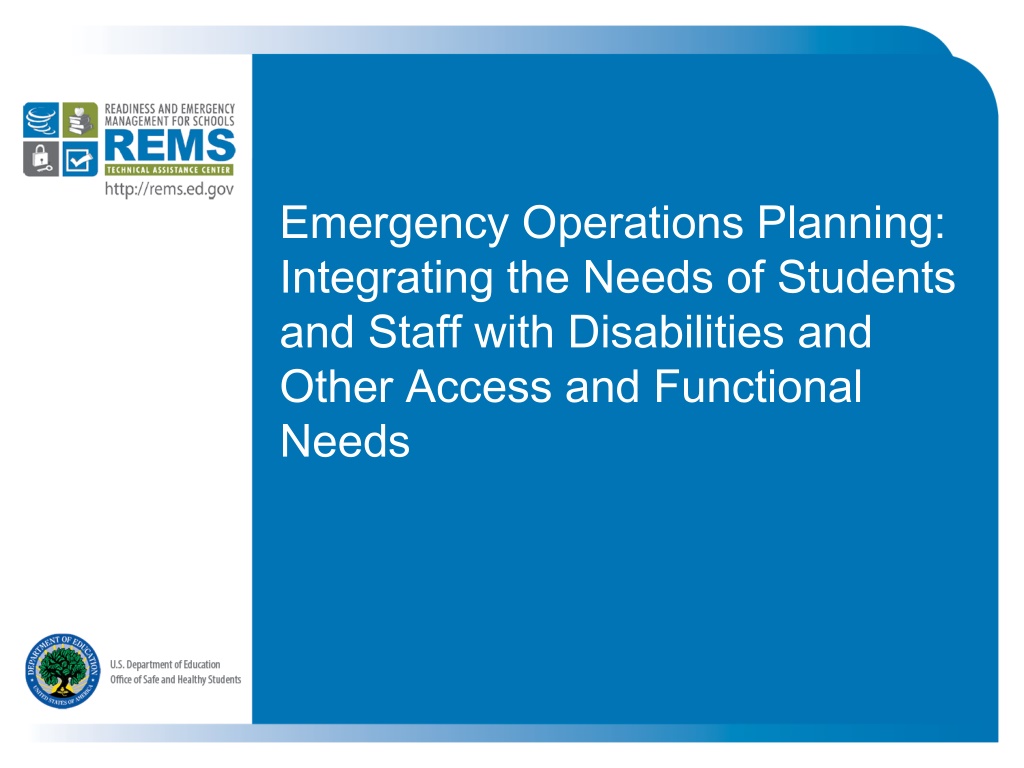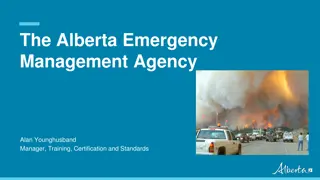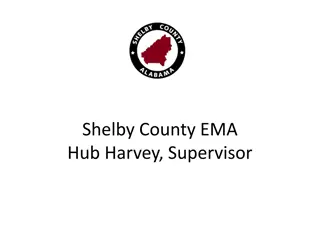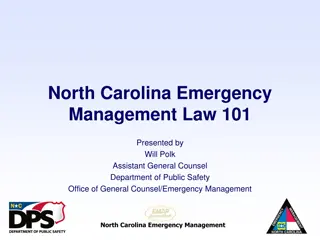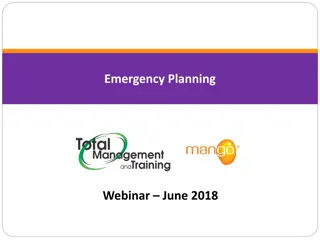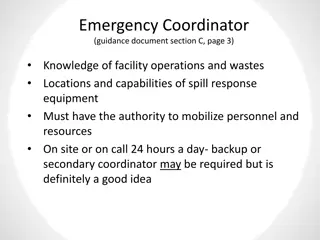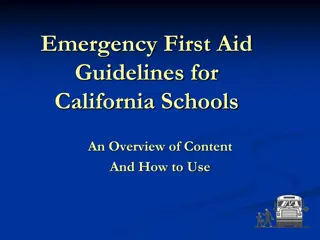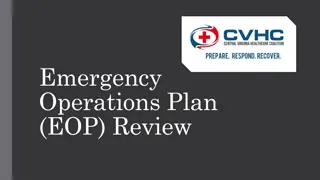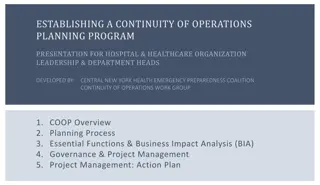Inclusive Emergency Operations Planning for Schools
This material focuses on integrating the needs of students and staff with disabilities and other access and functional needs into emergency operations planning. It covers the importance of the topic, overview of access and functional needs, types of disabilities, applicable laws, and six key planning principles to ensure a comprehensive approach in school emergency preparedness.
Download Presentation

Please find below an Image/Link to download the presentation.
The content on the website is provided AS IS for your information and personal use only. It may not be sold, licensed, or shared on other websites without obtaining consent from the author. Download presentation by click this link. If you encounter any issues during the download, it is possible that the publisher has removed the file from their server.
E N D
Presentation Transcript
Emergency Operations Planning: Integrating the Needs of Students and Staff with Disabilities and Other Access and Functional Needs
Presentation Outline Introduction to the topic Relevance of topic Overview of access and functional needs Range and types of disabilities and access and functional needs Applicable laws and statutes Six key planning principles Connection to the six step planning process Summary and next steps
Relevance of Topic Of the 50.1 million students in K-12 schools in the U.S., approximately 6.4 million have one or more disabilities; 95 percent of them attend mainstream schools. Not all schools comply with the functional and access requirements of the Americans with Disabilities Act (ADA) Students, staff, and others with disabilities and other access and functional needs may face unique challenges when responding to an emergency situation as regard to their: o Awareness of alert systems; o Clear understanding of the emergency situation; o Mobility; and o Communication. A comprehensive emergency operations plan must account for the entire school community.
Overview of Access and Functional Needs What are the access and functional needs that should be addressed by a school emergency operations plan (EOP)?
Range and Types of Disabilities and Access and Functional Needs Types of Disabilities and Access and Functional Needs: o Sensory o Physical o Cognitive/Developmental o Speech/Language o Social/Emotional/ Behavioral Range of Disabilities and Access and Functional Needs o Mild to severe o Apparent or not obvious o Short- or long term o Singular or multiple
Applicable Laws and Statutes Federal o Americans with Disabilities Act (ADA) o Individuals with Disabilities Education Act (IDEA) o Individuals with Disabilities in Emergency Preparedness (Executive Order No. 13347) o Nondiscrimination under Federal Grants and Programs (Section 504 of the Rehabilitation, Comprehensive Services, and Developmental Disabilities Act of 1978) State o Education Code Local o Board of Education policies
Comprehensive School EOPs Are Supported by Six Key Planning Principles Supported by Leadership Considers All Settings & All Times Collaborative Process Provides for Entire School Community Uses Assessments to Customize Takes an All- Hazards Approach
Connection to the Six Step Planning Process
Step 1: Form a Collaborative Planning Team Identify the Core Planning Team o Determine community partners (such as first responders, mental health and public health professionals, as well as representatives from the disability community). o Consider including teachers, counselors, school nurses, individualized education program (IEP) case managers, school psychologists, and transportation providers in your team. o Include students with disabilities or other access and functional needs, or their representatives, in planning activities.
Identify the Core Planning Team and Form a Common Framework Identify Core Planning Team Consider including the following individuals: School staff, such as teachers, counselors, school nurses, IEP case managers, school psychologists, and transportation providers; Students and staff with disabilities or other access and functional needs, or their representatives; Community partners, such as first responders, mental and public health professionals, and individuals from organizations that represent individuals with disabilities. Form a Common Framework
Define and Assign Roles and Responsibilities and Determine Regular Schedule of Meetings Define and Assign Roles and Responsibilities: Review all policies and procedures. Establish procedures for managing, maintaining, and operating specialized medical equipment and supplies. Serve as trainers to other community partners. Determine a Regular Schedule of Meetings: Facilitate discussions to get community buy-in and support.
Step 2: Understand the Situation In Step 2, schools will conduct a number of assessments to identify the threats and hazards that will be addressed in their school EOP. Two assessments that may reveal critical information about how threats and hazards impact individuals with disabilities and other access and functional needs include: 1. the Site Assessment; and 2. the Capacity Assessment.
Conducting a Site Assessment Check and then repair or modify pathways with access to assembly areas, evacuation routes, etc. Evaluate ADA Compliance: Width of doors is adequate. Floors are leveled. Electrical backups have been provided for. Universal symbols are used on signage. Toileting facilities ensure privacy. Emergency notification system addresses the access and functional needs of the entire school community, including those of persons with disabilities. Check regularly to ensure that all fire and safety codes are being met: o Hallways are clear and open. o Doors are not blocked.
Nine Areas to Guide a Site Assessment Personal health needs Getting around (wheelchairs) Transportation (specialized car/van) Electricity dependence Disaster debris Evacuation difficulty (e.g., from a floor above ground-level) Building exits Service animals Communication From the American Red Cross publication, Disaster Preparedness for People with Disabilities.
Conducting a Capacity Assessment Ensure that essential supplies and equipment are onsite: Check alert systems: Are they appropriate and relevant? For example, evacuation chairs for schools without elevators. Are these tested during drills and exercises?
Steps 3 & 4: Develop Goals, Objectives, and Courses of Action Cross-cutting functions to integrate the needs of individuals with disabilities and other access and functional needs Step 4: Plan Development (Identify Courses of Action) Step 3: Determine Goals and Objectives SCHOOL EOP THREAT AND HAZARD ANNEXES FUNCTIONAL ANNEXES BASIC PLAN
Functional Annexes Evacuation Family Reunification Lockdown Continuity of Operations Shelter-in-Place Recovery Accounting for All Persons Communications and Warning Public Health, Medical, and Mental Health Security
Evacuation Annex Evacuation considerations: o Can the individual navigate an exit route unassisted? o Will the individual know the exit route, even when not able to see it? o What are the alternative exit routes, devices, or assistance procedures? Considerations related to lending assistance: o Provide staff training on the appropriate procedures to lend assistance. o Plan for guide dogs to be evacuated with their owners. o Consider special transportation needs. Other Considerations: o Food and water. o Medications, medical equipment, and supplies.* *Connects to Public Health, Medical, and Mental Health Annex
Evacuation Annex (cont.) Prepare Go-Kits: Stockpile essential emergency supplies. Ensure that go-kits meet the needs of the individual student or staff member with the disability or access and functional need. Check your inventory periodically to ensure that equipment and supplies are in working order.
Lockdown Annex Lockdown considerations: Classroom size must be large enough to allow students and staff to move away from windows and doors. Students with mobility impairments can be moved to the interior of the classroom.
Shelter-in-Place Annex Considerations for sheltering in place: Access to toilets. Availability of medications. Food and necessary feeding equipment are accessible. Accommodations have been made for service animals. Appropriate activities for keeping students occupied are on-hand. Staff-to-student ratio is appropriate for extended stay in classroom.
Communications and Warning Annex Use communication systems to alert all students and staff, including those with disabilities and access and functional needs, to emergencies by using: Visual aids; Sign language; Large print signage; and Alarm systems (audible, visual).
Family Reunification Annex Considerations for addressing the needs of the entire school community during family reunification procedures include: Re-locating students to safe areas; Using staff who recognize students as well as parents and guardians; Following release procedures with parents and caretakers; and Implementing an established documentation process.
Recovery Annex Academic Recovery: o Return to a regular schedule as soon as possible. o Attempt to move forward with previously scheduled activities (e.g., graduation ceremony). o If necessary, design a split schedule. Physical Recovery: o Plan for utility disruptions. o Consider sharing space with neighboring schools.
Public Health, Medical, and Mental Health Annex To meet the medical needs of the entire school community, have: Safe and secure storage of necessary supplies and medicine; A 3-5 day supply of prescription medications; Secondary/backup equipment and supplies; Copies of physicians orders; and Mobile records. Examples of specialized equipment and supplies: Evacuation chairs Transfer-height cots Communication boards Oxygen tanks and masks Feeding tubes Wheelchairs (manual & electric) Gurneys Walkers Respirators
Step 5: Plan Preparation, Review, and Approval The emergency planning team reviews the plan, obtains official approval, and shares the plan with: o community partners, such as first responders; o local emergency management officials; o staff; and o stakeholders. Emergency planners should review the written plan for compliance with applicable laws and for its usefulness in practice.
Step 6: Plan Implementation and Maintenance In Step 6, the emergency planning team: Trains stakeholders on the plan and their roles in it; Exercises the plan; and Reviews, Revises, and Maintains the plan.
Train Stakeholders on the Plan and Their Roles Training topics may include: Learning about the types of disabilities and access and functional needs within the school How to work with service animals How to use specialized equipment and supplies How to lend assistance to vulnerable persons using appropriate emergency response techniques.
Exercise the Plan Practice evacuations, lockdowns, and shelter-in- place response procedures to ensure that: All populations are planned for adequately; and First responders are familiar with the unique needs of persons with disabilities and others with access and functional needs. Practice Conducting Drills and Exercises Using: American Sign Language Tactile sign Limited vision/ communication Picture books Braille Closed Circuit Television (CCTV) Computer-assisted communication Electronic text messaging
Family Educational Rights and Privacy Act (FERPA)
Health Insurance Portability and Accountability Act (HIPAA) Health information privacy standards HIPAA Federal, state, and other laws Civil Rights Laws
Summary and Next Steps This training has outlined several ways in which the needs of persons with disabilities and of others with access and functional needs can be integrated into each step of the EOP planning process. Based on what you ve learned in this training, identify: o Three new ways in which you plan to involve students or staff with disabilities or others with access and functional needs in your EOP planning process; and o Three new strategies you will add to your EOP to accommodate the needs of students or staff with disabilities or with access and functional needs during an emergency event.
Further Information Phone: (855) 781-7367 (REMS) Email: info@remstacenter.org Get the Guide Get the GuideGet the Guide http://rems.ed.gov Access Virtual Trainings Access Virtual Trainings Join our Community of Practice! Join our Community of Practice! Request an On-site Training Access Virtual Trainings Join our Community of Practice! Access Virtual Trainings Join our Community of Practice!
Acknowledgements Thank you to the original authors and contributors who developed and reviewed content for this presentation: Chris Dayian, Project Director, Safe Schools Center, Los Angeles County Office of Education Terri Wiseman, Business Manager, Florida School for the Deaf and the Blind Meloyde Batten-Mickens, Executive Director of Facilities/Public Safety, Gallaudet University Tom Gunnell, former Chief Operations Officer, Cincinnati Public School District Bonnie Gracer, U.S. Department of Education s Office of Special Education and Rehabilitative Services Bob Spears, former Director of Emergency Services, Los Angeles Unified School District This presentation was updated on September 22, 2014. This presentation was prepared for the U.S. Department of Education under Contract Number EDESE12O0036 with Synergy Enterprises, Inc. Madeline Sullivan served as the contracting officer s representative for the Readiness and Emergency Management for Schools (REMS) Technical Assistance (TA) Center. No official endorsement by the U.S. Department of Education of any product, commodity, service, or enterprise mentioned in this presentation is intended or should be inferred. For the reader s convenience, this presentation contains information about and from outside organizations, including hyperlinks and URLs. Inclusion of such information does not constitute an endorsement by the Department.
